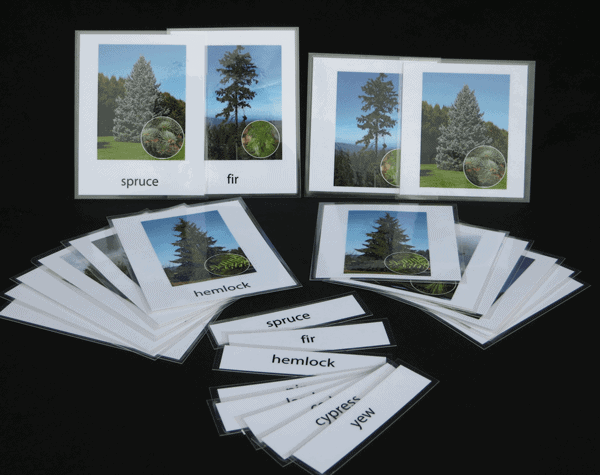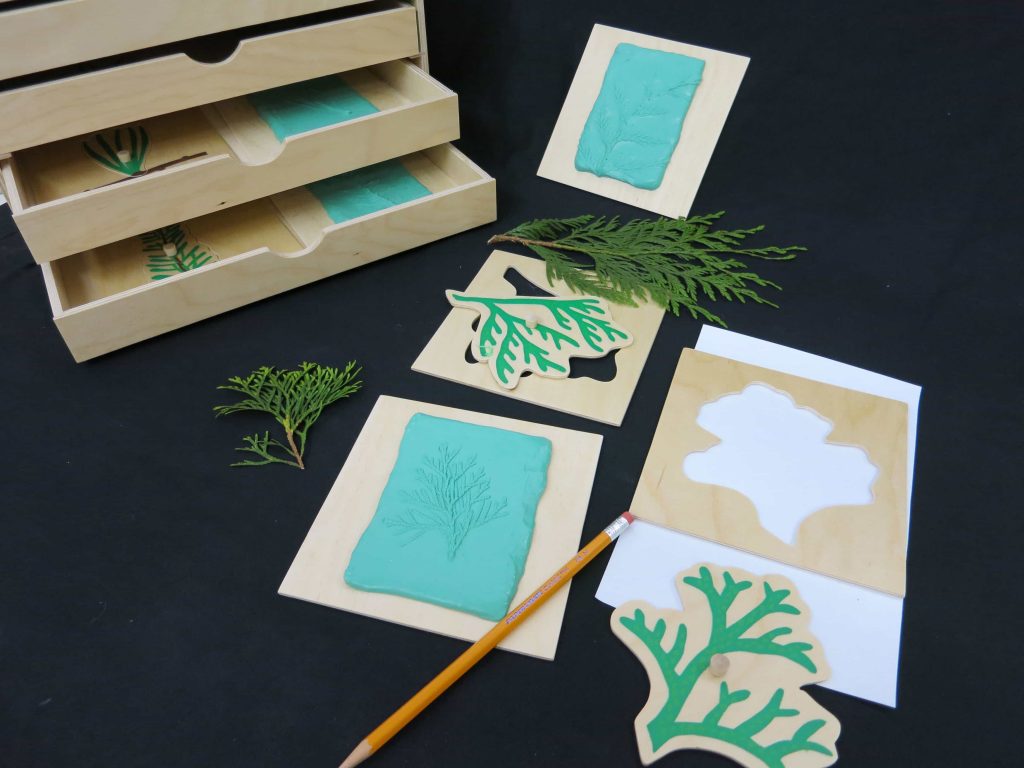Conifer Trees in the Winter
Winter is the perfect time of the year to examine evergreen branches of conifer trees. The deciduous trees are still dormant, most flowers are still sleeping too, but conifers are painting the town green! Exploring nature is not only fun for young children, but as Maria Montessori maintained, nature should be used to inspire children. Here are some easy ways to prepare some conifer preschool examination activities.
Did you know?
Conifer trees and evergreen trees are not necessarily the same thing! Hint: It all comes down to how they reproduce. If it’s by cones (like pine trees) – it’s a conifer. If it’s by flowers (like holly) – it’s an evergreen. Learn more about the differences here. And check out our nomenclature cards with pictures of both the trees, needles and cones here.
Gathering Evergreen Branches
Gathering materials for our projects was as easy as walking a city block with our young friends and collecting all the pinecones and branches we found scattered on the sidewalk left by the heavy wind and rains of the past week. We were also able to use our scissors and gather a few branches we snipped directly from our garden.
Let your child practice snipping!
Make sure you let your child do some of the snipping. As always with Montessori materials, ensuring your child has the right tools available and has been instructed how to safely use them, builds many practical life skills. Please don’t attempt this type of snipping with those all plastic “child’s” scissors, as those don’t even cut paper well at the best of times. Learning to cut with real scissors, sized for a child’s hands, are the best way to learn this skill. Snipping and cutting skills are a fundamental part of the Montessori curriculum. Children practice this by cutting straight, wavy and zig zaggy lines with paper “cutting strips”. You can find some Bald Eagle themed cutting strips here in the Bald Eagle Activity Bundle.
Lay your materials on a white background
The evergreens and conifer trees that surround us here in the Pacific Northwest can often look like a wall of undulating green set against the grey winter skies. Once the children are able to examine each of the branches and sprigs up close, laid out neatly on a white background, they could see clearly that the green branches had a large variety of shades from yellow to grey and even blue.
After examining the branches up close, why not try a few sensory activities?
Evergreen Science Sensory Play
Some of our favourite quick & easy sensory play activities to set up for a classroom or home school environment are sensory bottles and sensory tables.
We filled our bottle with oil, water and two drops of food colouring. After practicing snipping smaller clusters from the various branches you collected, place a few small branches and pine cones inside the prepared bottle. Younger children hold it up to the light, roll it along the ground and enjoy shaking it.

For our sensory table we place some larger branches from a variety of different evergreen trees and some larger pinecones in an inch of water and had some splashy, messy fun. A few eye droppers, a magnifying glass and some tongs added to the enjoyment and extended the play time. Picking up the branches and pinecones with the tongs is an excellent opportunity to practice developing fine motors skills and precision. Similarly, squeezing the eye droppers and working the tongs builds the muscles in the hands and fingers to strengthen the pincer grip.
Books About Trees
We are always on the lookout for great books (you can see our curated book list on our Pinterest page here). Many small local bookstores have also taken to doing online orders, telephone orders and may offer both curbside pickup and delivery. Make sure you try and support your local businesses during these difficult times. Check your local library for any new procedures they may have implemented. Our Fraser Valley Regional Library is also accepting online orders now with a contactless pickup in many locations. Here are some wonderful books about trees to inspire young minds:
Nature All Around – Trees
Book – 2019
This book explores the parts of the tree, life-cycle and the difference between deciduous and evergreen trees.
The Magic & Mystery of Trees
Book – 2019
An introduction to trees and forests, including how trees communicate and warn each other of predators, how they nurture their networks, record the past, and anticipate the future to
ensure their survival.
The Six Cedar Trees

Book – 2018
Eagle explores what lessons can we learn from our Coast Salish animals as he settles in a tall grove of cedar trees nestled in the corner of a school playground.
Building Pre-Reading Skills
Nomenclature cards, or 3-part cards, are another fundamental material used in the Montessori curriculum. The 3 parts include a control card with the image and word of the object or part, an object card with just the image and a label card with just the word. They are initially used by a teacher or parent to introduce the concepts and later children are able to self-correct without assistance.
How to use the cards
With pre-reading children you begin by laying out the control cards and work with the child to talk about what you see. You will not need the object (picture) or label cards yet. Start with just 4 or 5 cards. As you are presenting the control cards you can talk about what you see. “Does this look like a tree we saw today?” “Look at the shape of the branches we collected” “Are the needles soft or sharp?” Then you can introduce the name of the tree. “This is a hemlock tree” and ask the child to repeat it. Now you lay this card on the table or mat and pick up the next card and repeat.
Once your child remembers the names of the trees, you can add in the object (picture) cards and begin matching. You present the control cards as usual, but after that you demonstrate by taking each object card and matching it with the control card. At this point you can put all the cards away and have the child repeat the matching.
Match what you collected
The next fun part is more matching work, but you present the control cards as usual and then match the branches or cones you collected. Eventually you may increase the difficulty of this by using only the object (picture) cards and matching the branches or cones without the control cards. As you work through the image matching exercises and your child becomes ready for preliminary reading, you will later add in using the label cards too.
This is a great confidence builder. You can find our full colour, laminated conifer nomenclature cards in our online shop here.

We hope you have fun with some of these simple evergreen science activities for young learners. For those that are new to 3-part cards, you will be amazed at how quickly your little ones build confidence in this botany lesson and develop this enthusiasm for words and letters. Happy foraging!





